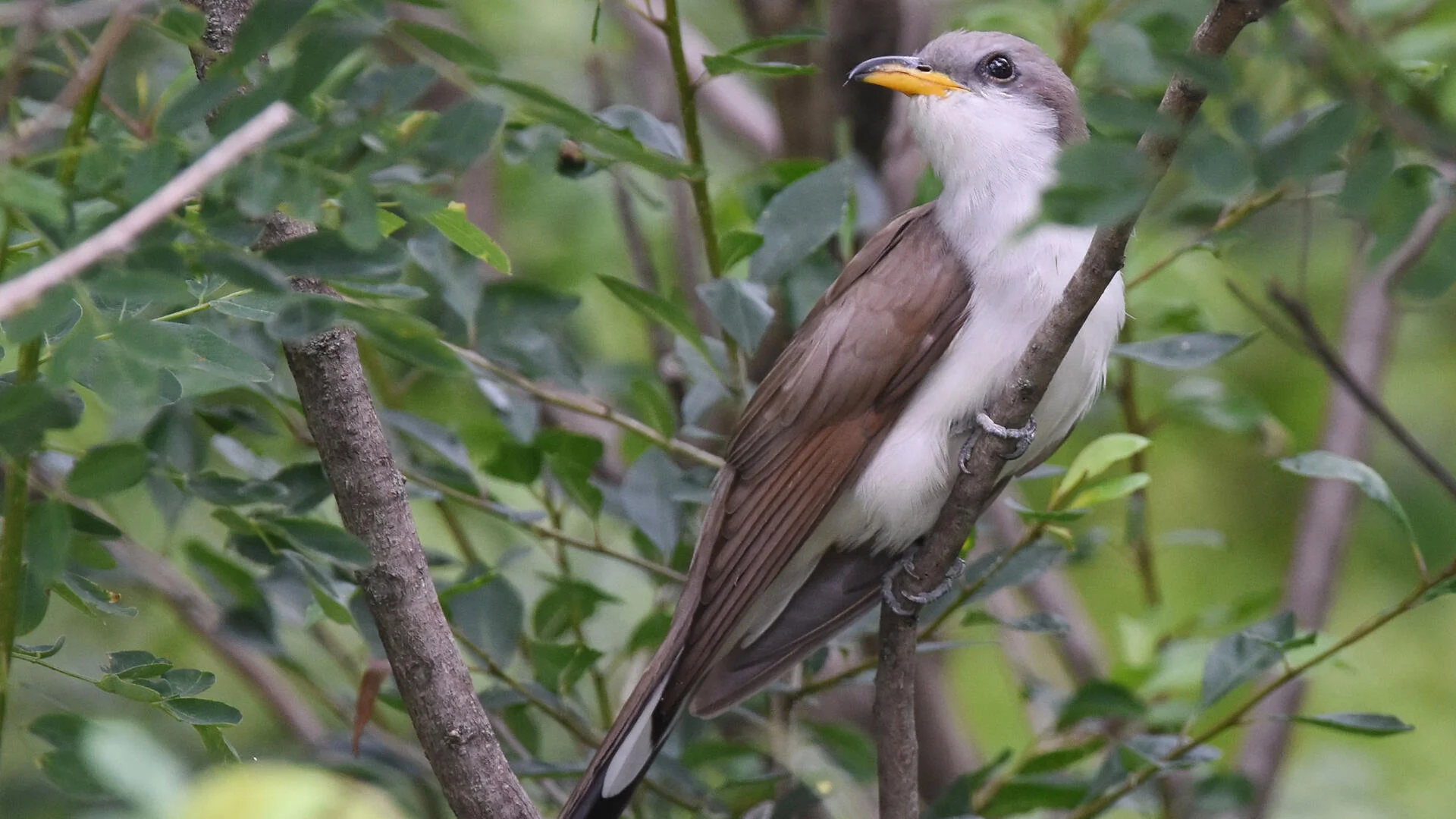During the spring and summer months in Iowa, when warblers and orioles make their appearance, it’s not uncommon to see yellow birds, particularly yellow warblers and orioles. However, in the winter, the American Goldfinch is the only yellow bird that can be easily spotted in the area.
To assist you in identifying the yellow birds you come across in Iowa, this guide offers pictures, information for identification, recordings of their songs, and details about their migration patterns.
In Iowa, most of the yellow birds you’ll encounter are warblers, orioles, or tanagers. Interestingly, some female birds of these species have a distinct appearance that differs greatly from the males.
This comprehensive guide provides all the necessary information to make identifying yellow birds a breeze. The list of yellow birds is organized based on their frequency of sightings in Iowa during the spring and summer months, according to ebird checklists from May and June.
Yellow Birds in Iowa Throughout the Year:
– American Goldfinch
Yellow Birds in Iowa During the Summer:
– Common Yellowthroat
– Baltimore Oriole
– Cedar Waxwing
– Eastern Meadowlark
– American Redstart
– Yellow Warbler
– Dickcissel
– Yellow-throated Vireo
– Orchard Oriole
– Scarlet Tanager
– Western Meadowlark
– Yellow-headed Blackbird
– Summer Tanager
– Yellow-throated Warbler
– Prothonotary Warbler
– White-eyed Vireo
– Western Kingbird
– Hooded Warbler
Yellow Birds in Iowa During Migration:
– Yellow-rumped Warbler
– Nashville Warbler
– Palm Warbler
– Magnolia Warbler
– Orange-crowned Warbler
– Wilson’s Warbler
– Black-throated Green Warbler
– Canada Warbler
– Blue-winged Warbler
– Cape May Warbler
– Pine Warbler
Accidental Yellow Birds in Iowa:
– Prairie Warbler
– Painted Bunting
– Evening Grosbeak
– Western Tanager
– Lesser Goldfinch
– Scott’s Oriole
– Hooded Oriole
So, continue reading to identify those yellow birds you’ve spotted.
30 Yellow Birds in Iowa:
1. American Goldfinch
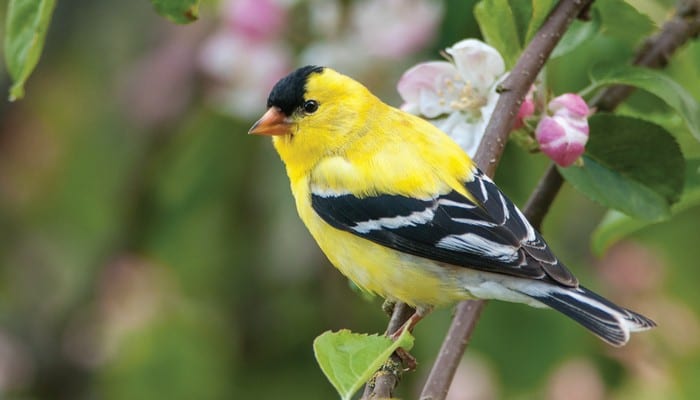
The American Goldfinch can be observed in Iowa throughout the year, but their numbers increase from May to September. Approximately 46% of summer checklists and 24% of winter checklists submitted by birdwatchers in the state record sightings of these vibrant yellow birds.
These goldfinches are highly sought after, especially during spring when the males display their bright yellow and black plumage. In contrast, the females have a more subdued brown coloring, similar to the appearance of males during the winter season.
Spinus tristis
Length: 4.3-5.1 in (11-13 cm)
Weight: 0.4-0.7 oz (11-20 g)
Wingspan: 7.5-8.7 in (19-22 cm)
American Goldfinches can be found in most parts of North America and are usually residents throughout the year. However, those that breed in Canada and the Midwest migrate to southern US states for the winter.
These charming birds can be spotted foraging in weedy fields, overgrown areas, suburban neighborhoods, parks, and even backyards. They have a preference for feeding on sunflower, thistle, and aster plants.
American Goldfinch Song:
The nests of American Goldfinches are typically built in shrubs using rootlets and plant materials woven together and securely fastened to branches with spider webs. These nests can contain up to seven eggs, which take around two weeks to hatch. The young
birds leave the nest after approximately two to two and a half weeks.
To attract American Goldfinches to your backyard, consider planting thistles and milkweed. They readily visit most bird feeders and particularly enjoy sunflower and nyjer seeds.
Fun Fact: Due to their exclusively vegetarian diet, American Goldfinches refuse to raise young cowbirds. The cowbird chicks, unable to thrive on such a diet, perish within a few days.
2. Common Yellowthroat

During the breeding season in Iowa, it’s common to spot Common Yellowthroats, which are present from mid-April to October. They appear in about 37% of summer checklists.
These small songbirds have brownish backs and vibrant yellow undersides, with long tails. Male Common Yellowthroats sport black masks across their faces, while the intensity of yellow coloration can vary geographically. Females often have more olive tones on their undersides.
Geothlypis trichas
Length: 4.3-5.1 in (11-13 cm)
Weight: 0.3-0.3 oz (9-10 g)
Wingspan: 5.9-7.5 in (15-19 cm)
Common Yellowthroats spend their summers breeding across most of North America, excluding Alaska and northern Canada. Some individuals remain along the Gulf Coast and in the Pacific Southwest throughout the year. They migrate south for the winter.
These yellow birds are commonly found in marshy or wetland areas, as well as brushy fields with thick, tangled vegetation.
Common Yellowthroat Song:
Credit: Paul Marvin, XC629250. Accessible at www.xeno-canto.org/629250.
Common Yellowthroat nests are constructed by females near the ground in marshy regions, using reeds for support. The nests are made of grass, sedges, and supported by leaves and grass platforms. They lay up to six eggs, which take approximately twelve days to hatch. The young birds leave the nest after a similar period.
To attract Common Yellowthroats to larger backyards, provide dense vegetation and native plants that attract insects.
Fun Fact: Common Yellowthroats vigorously defend their territory, attacking fake birds with black masks while remaining calm in the absence of masks.
3. Baltimore Oriole Female

Galveston Co., TX
May 2005
Baltimore Orioles are the second most frequently seen yellow birds during the summer in Iowa. They are spotted from April to September and appear in about 37% of summer checklists.
These birds add a splash of color to the eastern parts of North America during spring. Adult males display bright orange and black plumage, with white wing bars on their black wings.
Females exhibit yellowish undersides, head, and grayish-brown wings. Their backs are brownish-yellow. Although they are similar in size to robins, they possess a more slender physique and belong to the blackbird family.
Icterus galbula
Length: 6.7-7.5 in (17-19 cm)
Weight: 1.1-1.4 oz (30-40 g)
Wingspan: 9.1-11.8 in (23-30 cm)
Baltimore Orioles breed in Eastern and Central states, including central-southern Canadian provinces and the southern US border.
For the winter, they migrate to Florida, Central America, and the Caribbean, with some individuals leaving as early as July.
These vibrant birds are often found in open woodlands, riverbanks, forest edges, parks, and backyards. They primarily feed on insects and fruit, and sometimes, they can cause damage to crops such as raspberries, mulberries, cherries, bananas, and oranges.
Baltimore Oriole Sounds: The melodious flute-like sounds produced by Baltimore Orioles are a
delight in the spring. They also make chattering and sharp alarm calls.
Christopher McPherson, XC690956. Accessible at www.xeno-canto.org/690956.
To attract Baltimore Orioles to your backyard, try offering halved oranges on a platform feeder or hanging them from trees. Oriole feeders filled with sugar water can also entice them. Planting fruiting and nectar-rich plants such as raspberries, crab apples, and trumpet vines will further attract these beautiful birds.
Fun Fact: Baltimore Orioles construct remarkable bag-like nests woven from various materials.
4. Cedar Waxwing
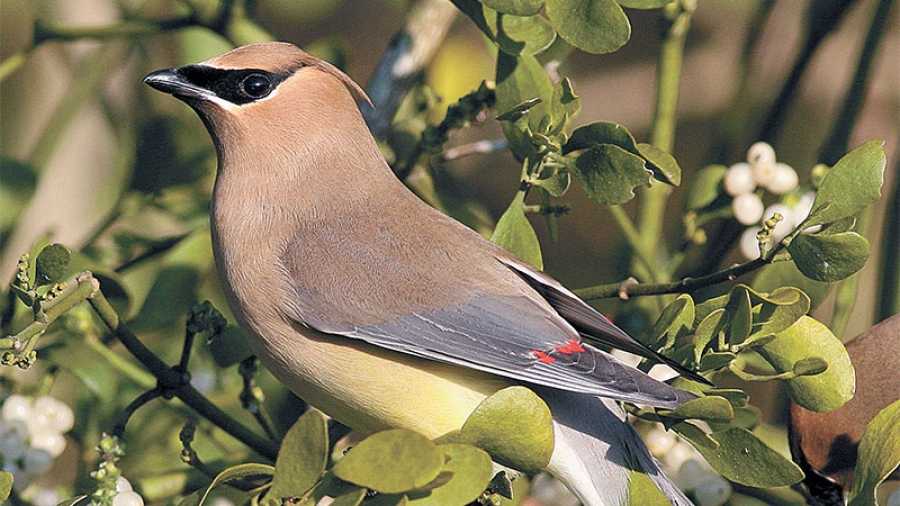
Cedar Waxwings are more frequently spotted in Iowa during the summer, from July to November. They appear in about 12% of checklists during this period. However, some individuals stay in the southern part of the state year-round.
Cedar Waxwings are elegant and sociable birds. They possess pale brown heads, chests, and crests that gradually transition to gray on their backs and wings, culminating in a tail. Their bellies are pale yellow, and their wingtips feature bright red accents. These birds also display narrow black masks over their eyes.
Bombycilla cedrorum
Length: 5.5-6.7 in (14-17 cm)
Weight: 1.1 oz (32 g)
Wingspan: 8.7-11.8 in (22-30 cm)
Cedar Waxwings breed in Canada before migrating to the southern United States, Mexico, and Central America for the winter. Some individuals remain in northern US states throughout the year.
These delightful birds can be found in berry bushes, woodlands, grasslands, towns, and along streams. While their diet primarily consists of fruit, they also consume insects during the summer.
Cedar Waxwing Call:
Credit: Peter Ward and Ken Hall, XC512254. Accessible at www.xeno-canto.org/512254.
Cedar Waxwing nests are built in trees using twigs, grass, hair, and plant materials. They are lined with pine needles and soft grass. The birds lay up to six eggs, which take about twelve days to hatch. The young waxwings leave the nest after approximately sixteen days.
To attract Cedar Waxwings to your backyard, consider planting native trees and shrubs that produce small fruits like serviceberry, dogwood, juniper, winterberry, and hawthorn. Additionally, try offering fruit on platform feeders.
Fun Fact: Cedar Waxwings engage in a unique behavior of passing gifts to potential mates during courtship rituals.
5. Yellow-rumped Warbler
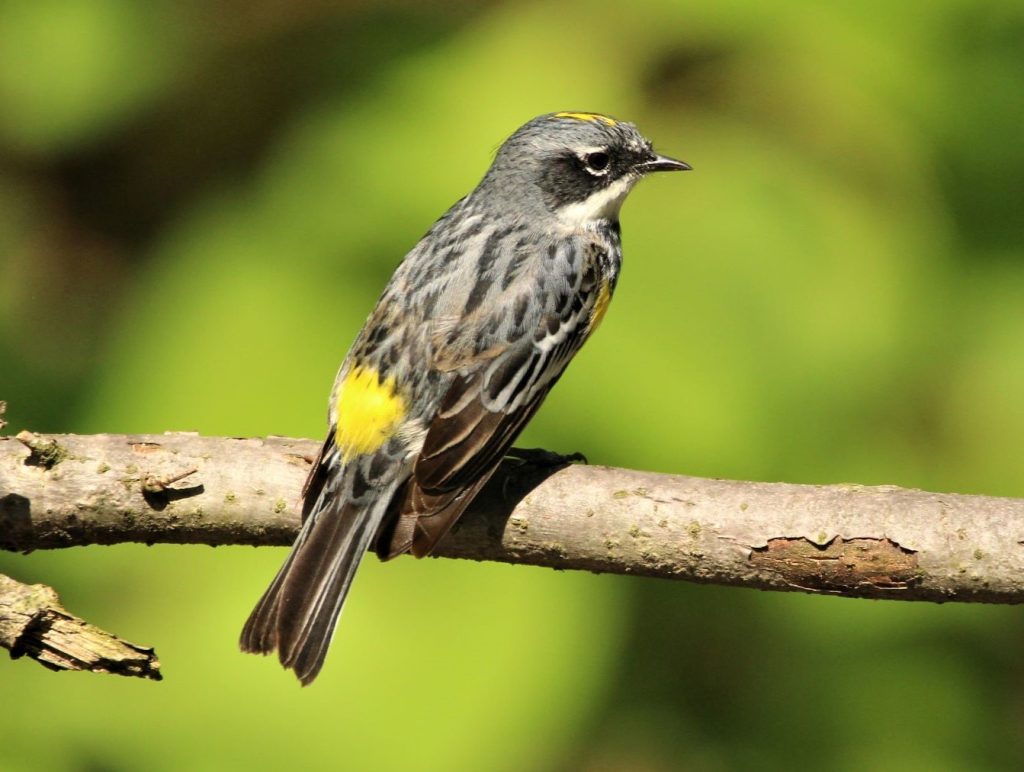
Yellow-rumped Warblers can be seen in Iowa during their migration periods from April to May and September to October. They are observed in up to 42% of checklists during these migration periods. Some individuals even winter in the southern part of the state.
Yellow-rumped Warblers feature gray plumage with flashes of yellow on their face, sides, and rump. They also exhibit white patterns in their wings.
Females may have a slightly brownish hue, while winter birds display paler brown tones with bright yellow rumps and sides that transition back to yellow and gray during spring.
Setophaga coronata
Length: 4.7-5.5 in (12-14 cm)
Weight: 0.4-0.5 oz (12-13 g)
Wingspan: 7.5-9.1 in (19-23 cm)
Yellow-rumped Warblers primarily breed in Canada, the Rockies, and the Appalachian mountains.
During migration, they can be observed in the Midwest. For the winter, they migrate to open areas with fruiting shrubs, along with southern and southwestern US states, the Pacific Coast, Mexico, and Central America.
These warblers are commonly found in coniferous forests, especially during the breeding season. In winter, they prefer open areas with fruiting shrubs. Their diet consists mainly of insects during summer and shifts to predominantly fruit, including bayberry and wax myrtle, during migration and winter.
Yellow-rumped Warbler Song:
Credit: Christopher McPherson, XC602699. Accessible at www.xeno-canto.org/602699.
Yellow-rumped Warblers construct their nests in conifer trees using twigs, pine needles, and grass. The nests are lined with soft grass, moss, and hair. They lay up to six eggs, which take about two weeks to hatch. The young birds leave the nest after a further two weeks.
To attract Yellow-rumped Warblers to your backyard, provide sunflower seeds, suet, raisins, and peanut butter.
Fun Fact: During winter, Yellow-rumped Warblers form flocks that can number in the thousands, often exhibiting aggressiveness towards other species that encroach on their space.
6. Eastern Meadowlark
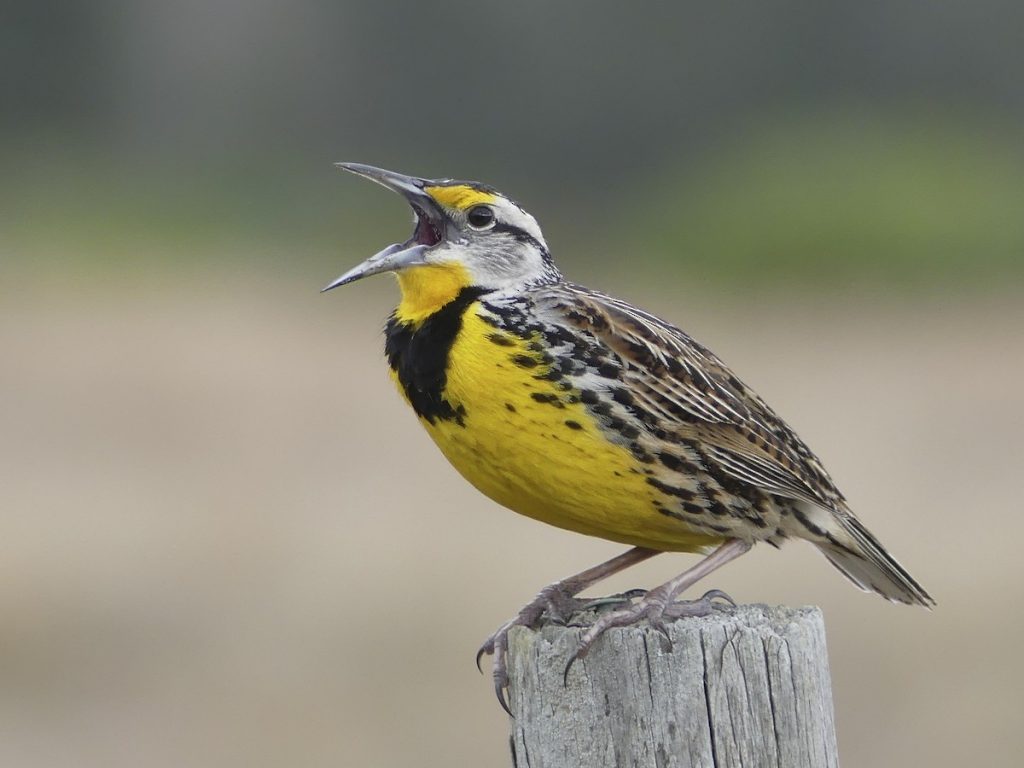
Eastern Meadowlarks, classified as near-threatened, can be seen mainly during the breeding season in Iowa. They are recorded in about 15% of summer checklists.
These medium-sized songbirds boast bright yellow undersides and pale brown plumage with black markings on their backs. They also possess a distinctive black band across their chests.
Sturnella magna
Length: 7.5-10.2 in (19-26 cm)
Weight: 3.2-5.3 oz (90-150 g)
Wingspan: 13.8-15.8 in (35-40 cm)
Eastern Meadowlarks can be found year-round throughout eastern US states. They also breed in the Northeast and Canada before migrating south.
The arrival of spring is marked by the melodious songs and impressive displays of Eastern Meadowlarks, although their near-threatened status is a concern.
These birds are typically found on the ground in grasslands, prairies, lightly grazed pastures, and along roadsides. They feed on insects and switch to seeds during winter, often gathering in large flocks in fields.
Eastern Meadowlark Sounds: They produce clear and melodious flute-like whistles.
Manuel Grosselet, XC645468. Accessible at www.xeno-canto.org/645468.
Eastern Meadowlarks construct intricate nests in grasses, shrubs, and trees up to four feet high. These nests incorporate tunnels and roofs made from woven grasses.
The female lays up to six eggs, which hatch in approximately two weeks. The young birds are ready to fly after around ten days.
Fun Fact: Eastern Meadowlarks can sing more than 100 different songs.
7. American Redstart Female
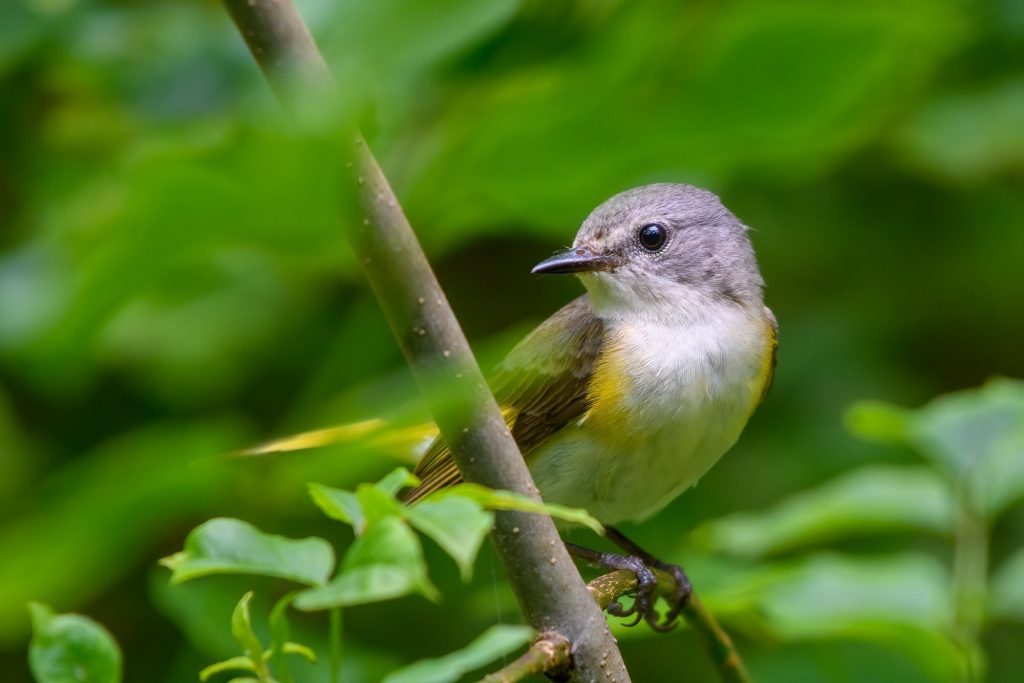
American Redstarts spend the breeding season in Iowa and can be observed from May to October. They appear in about 20% of summer checklists.
Male American Redstarts display predominantly black plumage with vibrant orange patches and a white belly. Females, on the other hand, feature olive-gray coloring instead of black, adorned with numerous yellow patches.
Setophaga ruticilla
Length: 4.3-5.1 in (11-13 cm)
Weight: 0.2-0.3 oz (6-9 g)
Wingspan: 6.3-7.5 in (16-19 cm)
American Redstarts breed in eastern US states and Canada, with some sightings occurring during migration in central and western US states.
These redstarts can be found in deciduous woodlands, backyards, and thickets, where they actively hunt for insects. Additionally, they feed on berries such as serviceberry and magnolia.
American Redstart Song:
Credit: Nick Kiehl, XC522368. Accessible at www.xeno-canto.org/522368.
American Redstarts build their nests close to the trunk of trees or large shrubs. The nests are constructed using bark, grass, and other plant materials. They lay up to five eggs, which hatch in just under two weeks. The young birds leave the nest within a week or two.
To attract American Redstarts to your backyard, provide berry plants like magnolia and serviceberry.
Fun Fact: American Redstart parents selectively feed certain chicks rather than all of them.
8. Yellow Warbler

Yellow Warblers can be observed in Iowa from mid-April to mid-October and appear in about 20% of summer checklists.
These small and brightly colored birds exhibit vibrant yellow plumage with a yellow-green back. Male Yellow Warblers have chestnut streaks on their breasts, while females and juveniles are not as brightly colored as males.
Setophaga petechia
Length: 4.7-5.1 in (12-13 cm)
Weight: 0.3-0.4 oz (9-11 g)
Wingspan: 6.3-7.9 in (16-20 cm)
Yellow Warblers undertake long migrations to breed in Canada and parts of the US, excluding southeastern states. They can also be observed during migration in southeastern US states.
These warblers are often found along streams, wetlands, thickets, and field edges, where they forage for insects such as caterpillars, midges, beetles, bugs, and wasps.
Yellow Warbler Song:
Credit: Richard E. Webster, XC662546. Accessible at www.xeno-canto.org/662546.
Yellow Warblers construct their nests in small trees or shrubs using bark, grass, and plant material woven together and secured with spider webs. The nests are then lined with softer materials like hair, feathers, and plant down.
They lay up to seven eggs, which take around twelve days to hatch. The young birds leave the nest after a further ten days.
To attract Yellow Warblers to your backyard, offer suet, oranges, peanut butter, and plants that bear berries. Additionally, plant native species that attract insects without the use of pesticides, and maintain a habitat that isn’t overly tidy. Birdbaths with fountains placed near secluded planting areas can provide additional protection.
Fun Fact: Yellow Warblers often build new nests on top of old ones, including the eggs, when cowbirds lay their eggs in their nests. This behavior can be repeated up to six times!
9. Dickcissel
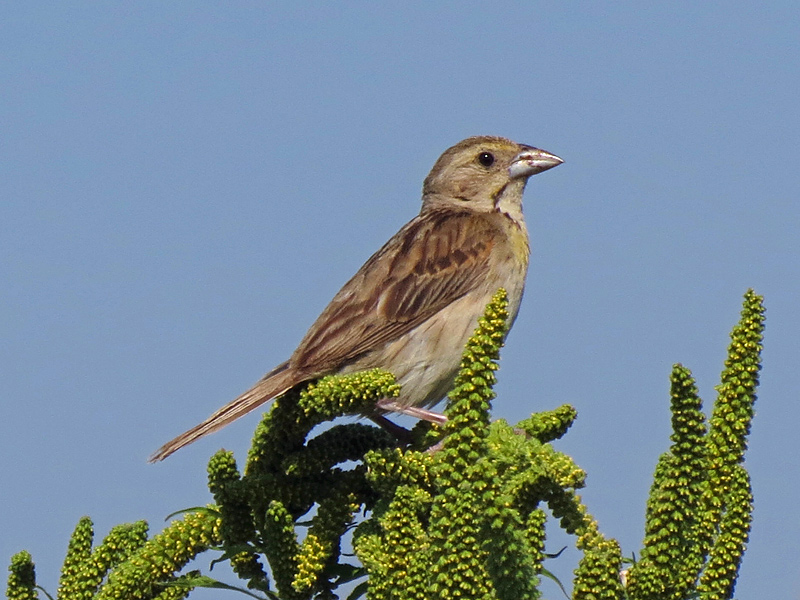
Dickcissels spend the breeding season in Iowa and are primarily observed from March to November. They appear in about 19% of checklists during this period.
Male Dickcissels are eye-catching, chunky birds with distinct black throat patches and yellow chests. Their grayish heads are accentuated by a striking yellow eyebrow line. Females display similar markings but with slightly paler or duller colors. However, they lack the black throat patch, and the yellow chest is more subtle.
Spiza americana
Length: 5.5-6.3 in (14-16 cm)
Weight: 0.9-1.4 oz (25.6-38.4 g)
Wingspan: 9.8-10.2 in (24.8-26 cm)
Dickcissels breed in the Central and Great Plains of the US before migrating to Mexico, Central America, and northern South America.
These birds can be found in meadows, prairies, tall grasslands, light-gr
azed pastures, and along roadsides. They primarily feed on insects during the summer and switch to seeds, including cultivated grain, during other times of the year.
Dickcissel Song:
Credit: Paul Driver, XC658547. Accessible at www.xeno-canto.org/658547.
Dickcissels build nests in thick shrubs, grasses, and trees, generally up to four feet high. The nests are composed of weeds, grass, leaves, and lined with fine grass and animal hair. The female may lay up to six eggs, which hatch in two weeks. The young birds are ready to fly after approximately ten days.
Fun Fact: During fall migration, Dickcissels gather in large numbers, sometimes reaching millions when they reach their winter grounds.
10. Yellow-throated Vireo
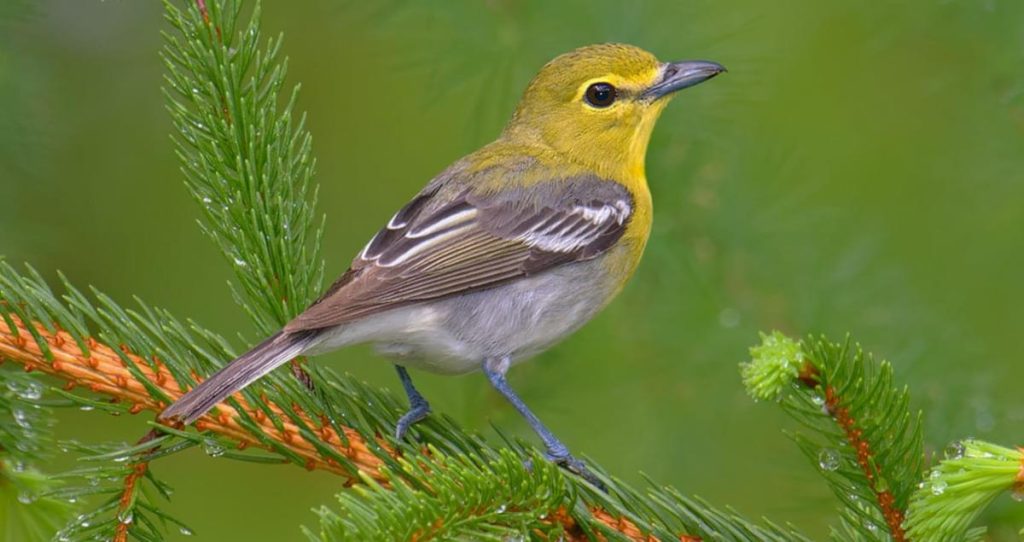
Yellow-throated Vireos spend the breeding season in Iowa and can be observed from mid-April to September. They are recorded in about 10% of summer checklists.
Yellow-throated Vireos are bright yellow and gray birds with olive-colored heads. They boast bright yellow throats and chests, white bellies, and grayish-brown backs adorned with white streaks.
Vireo flavifrons
Length: 5.1-5.9 in (13-15 cm)
Weight: 0.5-0.7 oz (15-21 g)
Wingspan: 9.1 in (23 cm)
Yellow-throated Vireos breed in eastern US states and spend their winters in Central and South America, as well as the Caribbean.
These vireos can be found in mixed woodlands, where they actively hunt for insects. They may also feed on berries at times.
Yellow-throated Vireo Song:
Credit: Phoenix Birder, XC574089. Accessible at www.xeno-canto.org/574089.
Yellow-throated Vireos build hanging cup-shaped nests high up in trees. These nests are constructed using bark, grass, pine needles, and other plant materials, secured with spider webs and insect silk.
They lay approximately four eggs, which hatch in around two weeks. The young birds leave the nest after a further two weeks.
Fun Fact: Male Yellow-throated Vireos create small piles of twigs in various locations as part of their courtship display, hoping to attract females.
11. Orchard Oriole
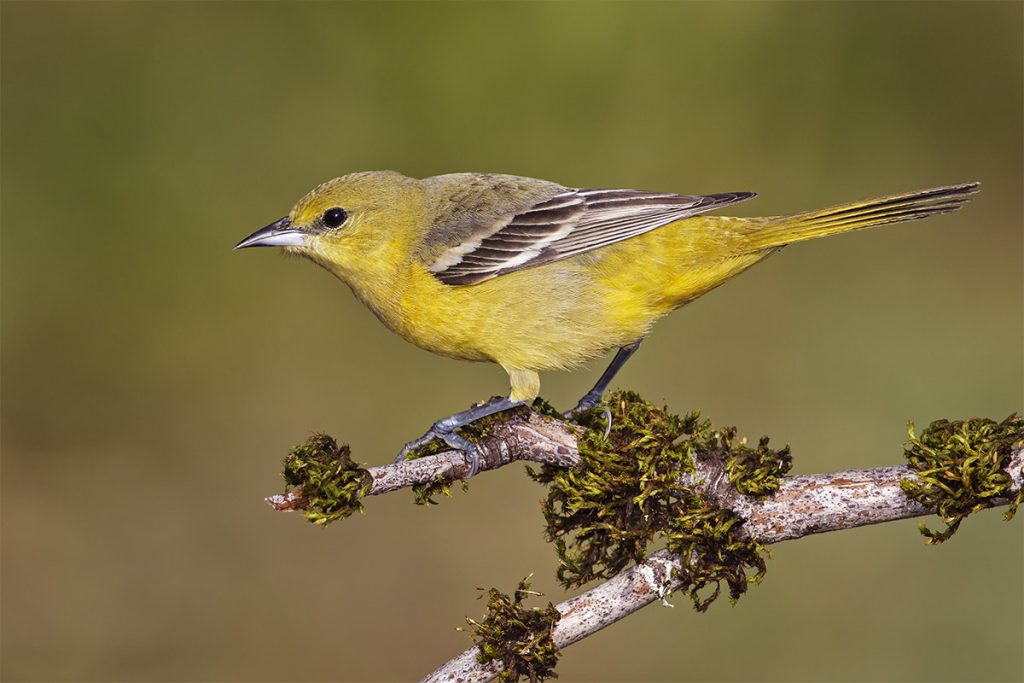
Galveston Co., TX
April 2012
Orchard Orioles can be seen in Iowa during the summer months, from May to August. They appear in about 7% of summer checklists.
Male Orchard Orioles showcase a vibrant orange color with black wings and a black head. The females, however, are more subtly colored with olive-green plumage and yellowish undersides.
Icterus spurius
Length: 6.3-7.1 in (16-18 cm)
Weight: 0.6-0.9 oz (17-26 g)
Wingspan: 9.1-10.2 in (23-26 cm)
Orchard Orioles breed in eastern and central United States, as well as southern Canada. They migrate to Mexico, Central America, and northern South America for winter.
You can find Orchard Orioles in open woodlands, orchards, and forest edges. They feed on insects, nectar, and fruits.
Orchard Oriole Song:
Credit: Mike Nelson, XC570109. Accessible at www.xeno-canto.org/570109.
Nests of Orchard Orioles are intricately woven cups made from grass, plant fibers, and fine materials. They are typically suspended from branches. The female lays up to five eggs, which hatch in about two weeks. The young birds leave the nest after another two weeks.
To attract Orchard Orioles, provide fruit feeders, nectar feeders, and plant fruit-bearing trees and shrubs.
Fun Fact: Male Orchard Orioles may mate with multiple females and help with nesting duties, including feeding the young.
12. Scarlet Tanager
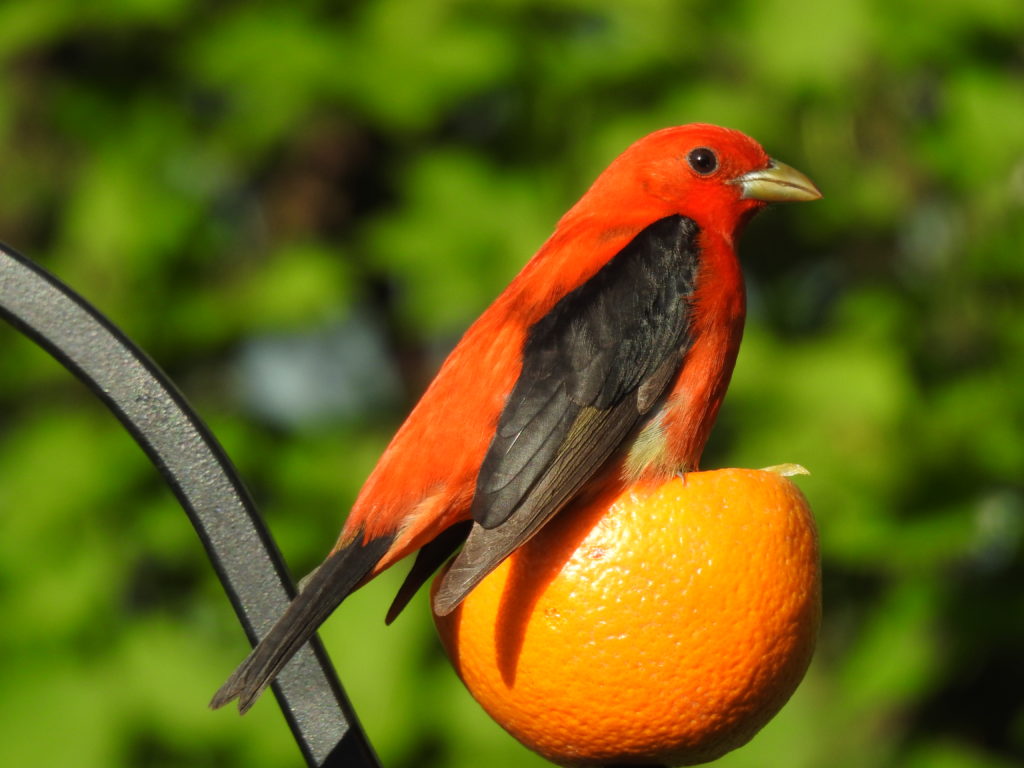
Scarlet Tanagers can be spotted in Iowa during the breeding season from May to August. They appear in about 8% of summer checklists.
Male Scarlet Tanagers are known for their brilliant scarlet plumage, while females exhibit a more subtle olive-yellow color.
Piranga olivacea
Length: 6.3-7.1 in (16-18 cm)
Weight: 0.7-1.0 oz (20-28 g)
Wingspan: 9.8-11.8 in (25-30 cm)
Scarlet Tanagers breed in the eastern and central United States and parts of Canada. They migrate to northern South America for winter.
These tanagers prefer mature deciduous forests, where they forage for insects and occasionally eat fruits.
Scarlet Tanager Song:
Credit: Andrew Spencer, XC414605. Accessible at www.xeno-canto.org/414605.
Nests of Scarlet Tanagers are built in the fork of horizontal tree branches. The nests are made from twigs, grass, and leaves, lined with finer materials. The female lays three to five eggs, which incubate for about two weeks. The young birds fledge after two weeks.
To attract Scarlet Tanagers, provide a habitat with mature trees and offer suet, mealworms, and fruits.
Fun Fact: Scarlet Tanagers undergo a complete molt after breeding, replacing their bright red plumage with a yellow-green plumage resembling females and immatures.
13. Western Meadowlark
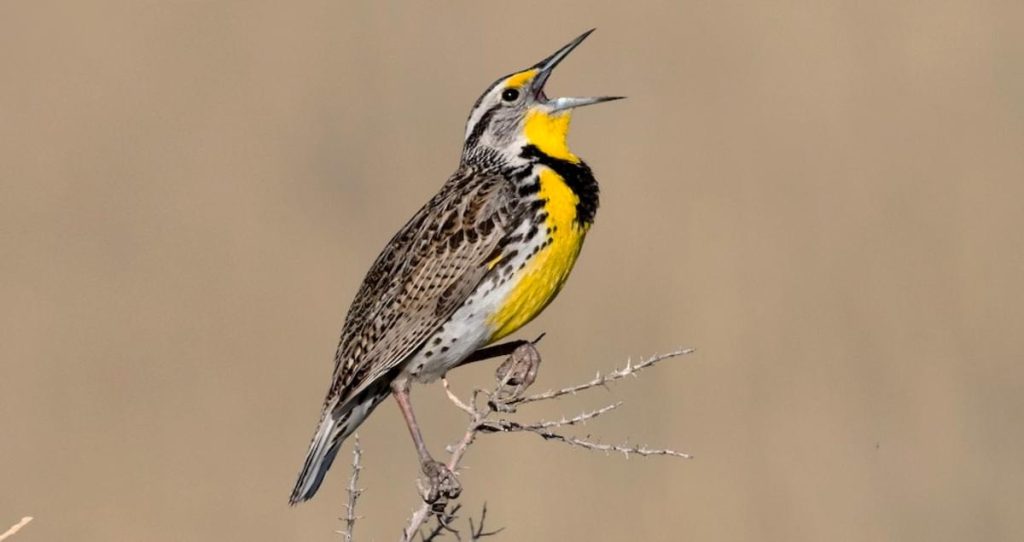
Western Meadowlarks can be observed in Iowa during the breeding season from April to August. They appear in about 17% of summer checklists.
Western Meadowlarks exhibit bright yellow undersides with brown streaking on their back and wings. They have a distinct black “V” pattern on their chests.
Sturnella neglecta
Length: 7.1-10.2 in (18-26 cm)
Weight: 4.6-6.2 oz (130-175 g)
Wingspan: 14.2-16.1 in (36-41 cm)
Western Meadowlarks breed across western and
central North America. Some populations are resident year-round, while others migrate to the southern United States and Mexico for winter.
You can find Western Meadowlarks in grasslands, prairies, pastures, and fields. They feed primarily on insects, seeds, and fruits.
Western Meadowlark Sounds:
Credit: Andrew Spencer, XC415138. Accessible at www.xeno-canto.org/415138.
Nests of Western Meadowlarks are built on the ground, often hidden within vegetation. They are constructed using grasses and plant materials, lined with finer grasses and hair. The female lays three to six eggs, which incubate for about two weeks. The young birds leave the nest after another two weeks.
To attract Western Meadowlarks, provide open areas with tall grasses and avoid excessive mowing or grazing.
Fun Fact: The Western Meadowlark is the state bird of six U.S. states: Kansas, Montana, Nebraska, North Dakota, Oregon, and Wyoming.
14. Yellow-headed Blackbird

Yellow-headed Blackbirds can be seen in Iowa during the summer months, from May to August. They appear in about 5% of summer checklists.
Male Yellow-headed Blackbirds showcase striking yellow heads and breasts with black bodies. Females, however, exhibit more subdued colors with streaked brown plumage.
Xanthocephalus xanthocephalus
Length: 8.7-10.2 in (22-26 cm)
Weight: 3.2-5.1 oz (90-145 g)
Wingspan: 14.2-16.1 in (36-41 cm)
Yellow-headed Blackbirds breed in the western and central United States and parts of Canada. They migrate to the southwestern United States and Mexico for winter.
These blackbirds are typically found in marshes, wetlands, and meadows, where they feed on insects, seeds, and grains.
Yellow-headed Blackbird Sounds:
Credit: Andrew Spencer, XC558912. Accessible at www.xeno-canto.org/558912.
Nests of Yellow-headed Blackbirds are built in marshes and wetlands, typically among cattails or bulrushes. The nests are constructed from wet vegetation and plant materials. The female lays three to five eggs, which incubate for about two weeks. The young birds fledge after another two weeks.
To attract Yellow-headed Blackbirds, create wetland or marsh-like habitats and offer mixed birdseed and cracked corn.
Fun Fact: Male Yellow-headed Blackbirds aggressively defend their territory, often engaging in aerial displays to establish dominance.
15. Summer Tanager

Summer Tanagers can be observed in Iowa during the summer months, from May to August. They appear in about 7% of summer checklists.
Male Summer Tanagers display a vibrant red plumage, while females exhibit a more subtle yellowish-olive color.
Piranga rubra
Length: 6.3-7.5 in (16-19 cm)
Weight: 0.9-1.0 oz (25-28 g)
Wingspan: 10.2-11.8 in (26-30 cm)
Summer Tanagers breed in the southeastern and southwestern United States and parts of Mexico. They migrate to northern South America for winter.
These tanagers can be found in forests, woodlands, and parks. They primarily feed on flying insects, including bees, wasps, and beetles.
Summer Tanager Song:
Credit: Jonathon Jongsma, XC578784. Accessible at www.xeno-canto.org/578784.
Nests of Summer Tanagers are built on horizontal branches, usually in the canopy of trees. The nests are constructed using twigs, grass, and other plant materials,
lined with finer materials. The female lays three to four eggs, which hatch in about two weeks. The young birds fledge after another two weeks.
To attract Summer Tanagers, provide a habitat with mature trees, offer fruit feeders, and avoid pesticide use.
Fun Fact: Summer Tanagers are known for their unique feeding behavior called “gleaning,” where they catch insects mid-air and then beat them against branches to remove wings and other unwanted parts.
16. Yellow-throated Warbler
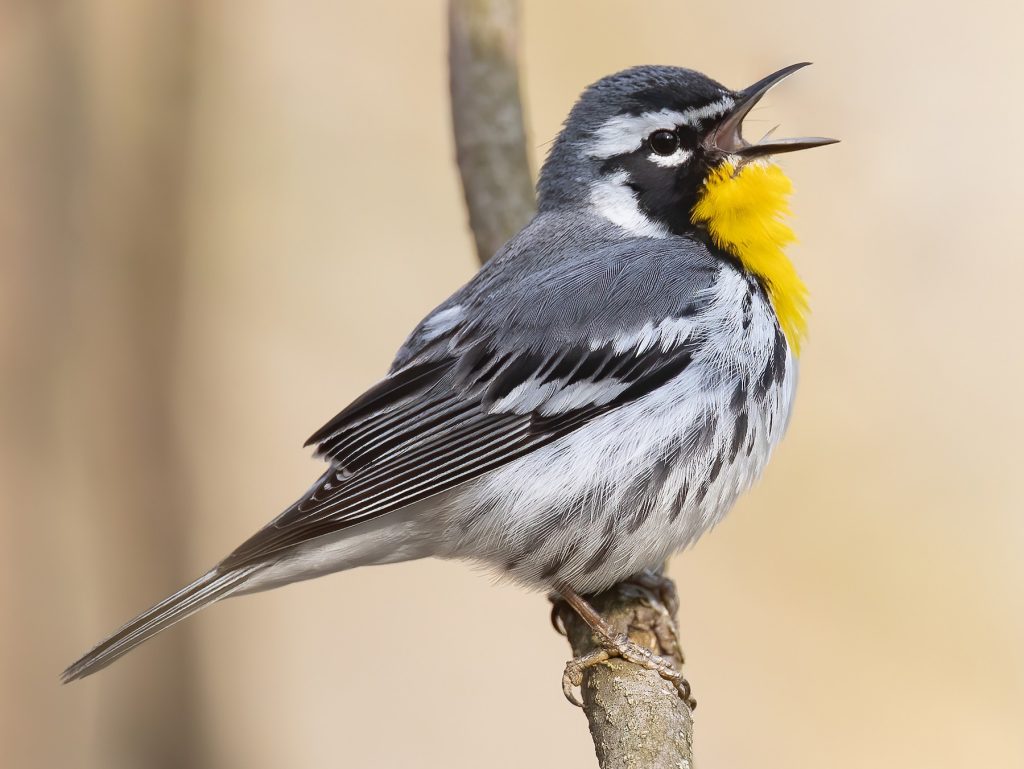
Yellow-throated Warblers can be spotted in Iowa during the migration seasons, from April to May and September to October. They are recorded in up to 8% of checklists during migration.
Yellow-throated Warblers exhibit a yellow throat and chest, gray upperparts, and a white belly. They have distinct black streaking on their sides and a black line through their eyes.
Setophaga dominica
Length: 5.5-5.9 in (14-15 cm)
Weight: 0.4-0.5 oz (11-14 g)
Wingspan: 8.7-9.4 in (22-24 cm)
Yellow-throated Warblers breed in the southeastern United States and parts of the Midwest. They migrate to the southeastern United States, Mexico, and Central America for winter.
During migration, these warblers can be found in various habitats, including woodlands, forests, and wet areas. They primarily feed on insects.
Yellow-throated Warbler Sounds:
Credit: Paul Driver, XC651372. Accessible at www.xeno-canto.org/651372.
Nests of Yellow-throated Warblers are built in trees, usually in deciduous forests. The nests are constructed using twigs, bark, moss, and other plant materials, lined with softer materials like hair and feathers. The female lays three to five eggs, which hatch in about two weeks. The young birds leave the nest after another two weeks.
To attract Yellow-throated Warblers during migration, provide a habitat with diverse tree species and offer insects through natural gardening practices.
Fun Fact: Yellow-throated Warblers have a unique habit of wedging large insects into tree bark crevices to help immobilize and break them apart before feeding.
17. Prothonotary Warbler
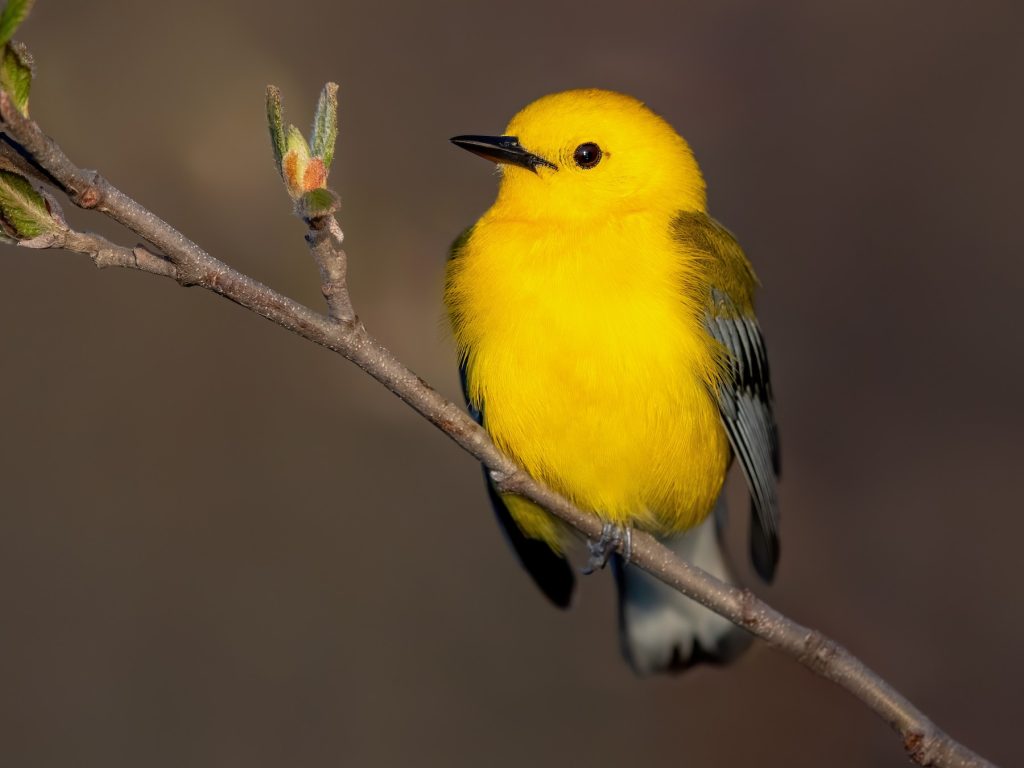
Prothonotary Warblers can be observed in Iowa during the migration seasons, from April to May and September to October. They are recorded in up to 5% of checklists during migration.
Prothonotary Warblers exhibit bright yellow plumage with a gray-blue back and wings. They have a distinctive orange head and a relatively long, narrow beak.
Protonotaria citrea
Length: 4.3-5.1 in (11-13 cm)
Weight: 0.4-0.5 oz (11-14 g)
Wingspan: 6.7-7.5 in (17-19 cm)
Prothonotary Warblers breed in the southeastern United States and parts of the Midwest. They migrate to the Gulf Coast, Central America, and northern South America for winter.
These warblers are typically found in swampy or marshy areas with standing water, where they forage for insects.
Prothonotary Warbler Sounds:
Credit: Mike Nelson, XC538448. Accessible at www.xeno-canto.org/538448.
Nests of Prothonotary Warblers are built in tree cavities, often near or over water. The nests are constructed using moss, bark, grass, and other plant materials. The female lays four to seven eggs, which incubate for about two weeks. The young birds leave the nest after another two weeks.
To attract Prothonotary Warblers during migration, provide nest boxes near water sources and create wetland or marsh-like habitats.
Fun Fact: Prothonotary Warblers are the only eastern warblers that nest in natural or artificial cavities instead of building cup-shaped nests.
18. White-eyed Vireo
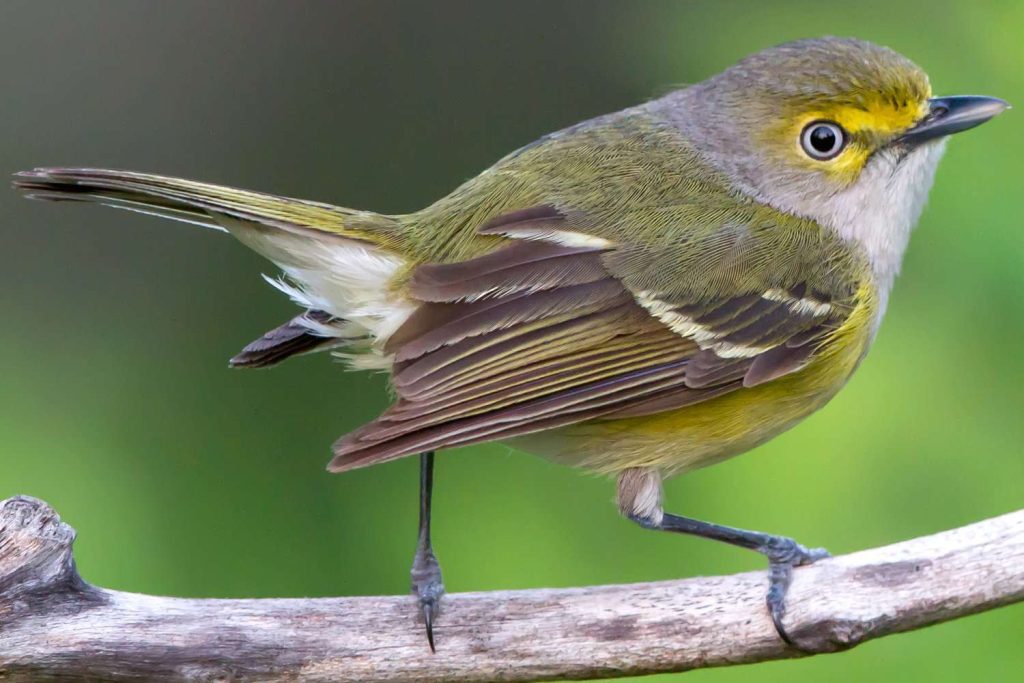
White-eyed Vireos can be seen in Iowa during the migration seasons, from April to May and September to October. They are recorded in up to 6% of checklists during migration.
White-eyed Vireos exhibit a bright yellow-green body with a white iris, giving them their distinctive white-eyed appearance.
Vireo griseus
Length: 4.7-5.1 in (12-13 cm)
Weight: 0.4-0.5 oz (11-14 g)
Wingspan: 7.5-8.7 in (19-22 cm)
White-eyed Vireos breed in the southeastern United States and parts of the Midwest. They migrate to Mexico and Central America for winter.
These vireos can be found in shrubby areas, brushy thickets, and woodland edges, where they forage for insects and spiders.
White-eyed Vireo Sounds:
Credit: Paul Driver, XC693674. Accessible at www.xeno-canto.org/693674.
Nests of White-eyed Vireos are typically built in low shrubs or small trees. The nests are constructed using bark strips, grass, and other plant materials, often woven together in a cup shape. The female lays three to five eggs, which hatch in about two weeks. The young birds leave the nest after another two weeks.
To attract White-eyed Vireos during migration, provide a habitat with dense shrubs and thickets.
Fun Fact: White-eyed Vireos are known for their complex songs, which include a variety of notes, phrases, and imitations of other bird species.
19. Western Kingbird
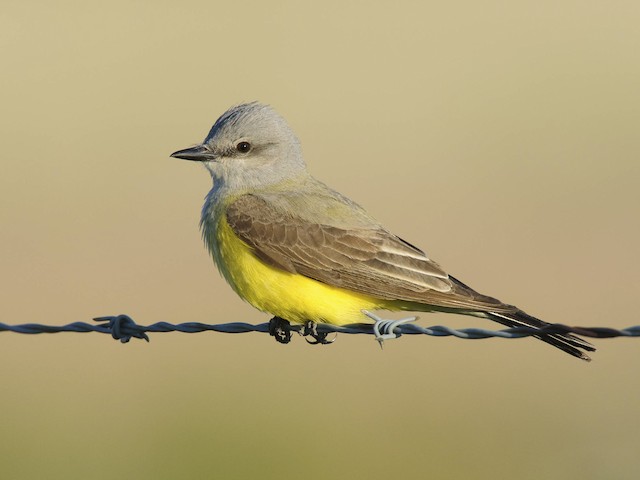
Western Kingbirds can be observed in Iowa during the summer months, from May to August. They appear in about 12% of summer checklists.
Western Kingbirds exhibit a gray back, a yellow belly, and a white throat with a contrasting black mask. They have a relatively large head and a sturdy beak.
Tyrannus verticalis
Length: 7.5-9.1 in (19-23 cm)
Weight: 1.1-1.3 oz (30-37 g)
Wingspan: 15.0-16.9 in (38-43 cm)
Western Kingbirds breed in the western United States and parts of Canada. They migrate to Mexico and Central America for winter.
These kingbirds are commonly found in open habitats such as grasslands, savannas, and agricultural areas. They feed on insects, including flying insects caught in mid-air.
Western Kingbird Sounds:
Credit: Andrew Spencer, XC563287. Accessible at www.xeno-canto.org/563287.
Nests of Western Kingbirds are built on horizontal branches of trees or structures such as utility poles and fence posts. The nests are constructed using twigs, grass, rootlets, and other plant materials, lined with softer materials like feathers and fur. The female lays three to five eggs, which hatch in about two weeks. The young birds leave the nest after another two weeks.
To attract Western Kingbirds, provide open perching spots, such as dead snags or high perches, and avoid pesticide use to maintain insect populations.
Fun Fact: Western Kingbirds are known for their aggressive behavior, often chasing away larger birds that intrude upon their territory.
20. Hooded Warbler
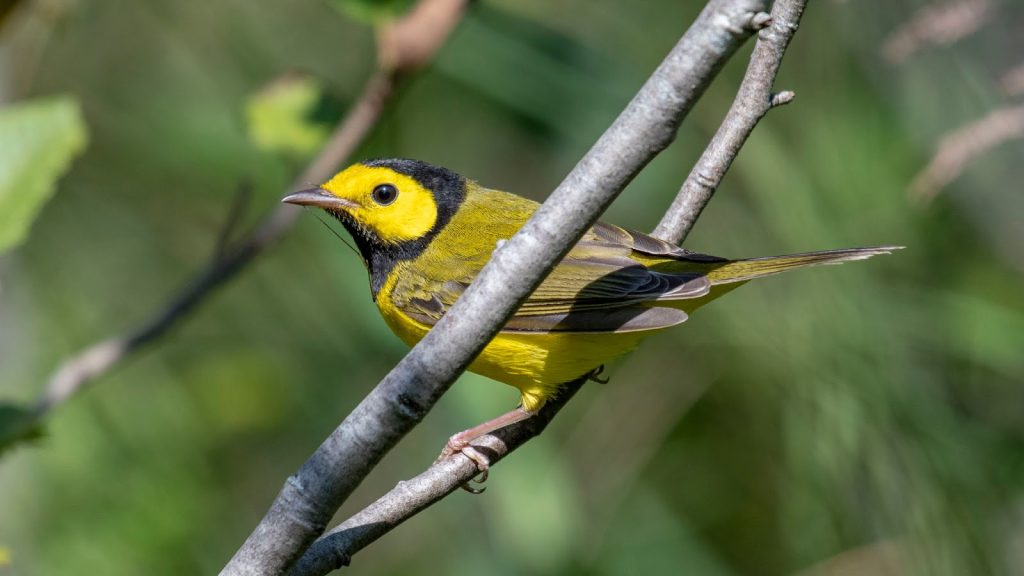
Hooded Warblers can be spotted in Iowa during the migration seasons, from April to May and September to October. They are
recorded in up to 4% of checklists during migration.
Hooded Warblers exhibit a bright yellow body with a black hood that extends from their face to their upper chest.
Setophaga citrina
Length: 4.3-4.7 in (11-12 cm)
Weight: 0.3-0.4 oz (9-11 g)
Wingspan: 6.7-7.1 in (17-18 cm)
Hooded Warblers breed in the eastern United States and parts of the Midwest. They migrate to Mexico, Central America, and northern South America for winter.
During migration, these warblers can be found in various habitats, including forests, woodland edges, and thickets. They primarily feed on insects.
Hooded Warbler Sounds:
Credit: Paul Driver, XC651459. Accessible at www.xeno-canto.org/651459.
Nests of Hooded Warblers are built on or near the ground, typically hidden among leaf litter and vegetation. The nests are constructed using leaves, grasses, and other plant materials, lined with finer materials. The female lays three to five eggs, which hatch in about two weeks. The young birds leave the nest after another two weeks.
To attract Hooded Warblers during migration, provide a habitat with dense understory vegetation and leaf litter.
Fun Fact: Hooded Warblers are known for their distinctive “weeta weeta weeteeo” song, which is often heard in their breeding territories.
21. Yellow-billed Cuckoo
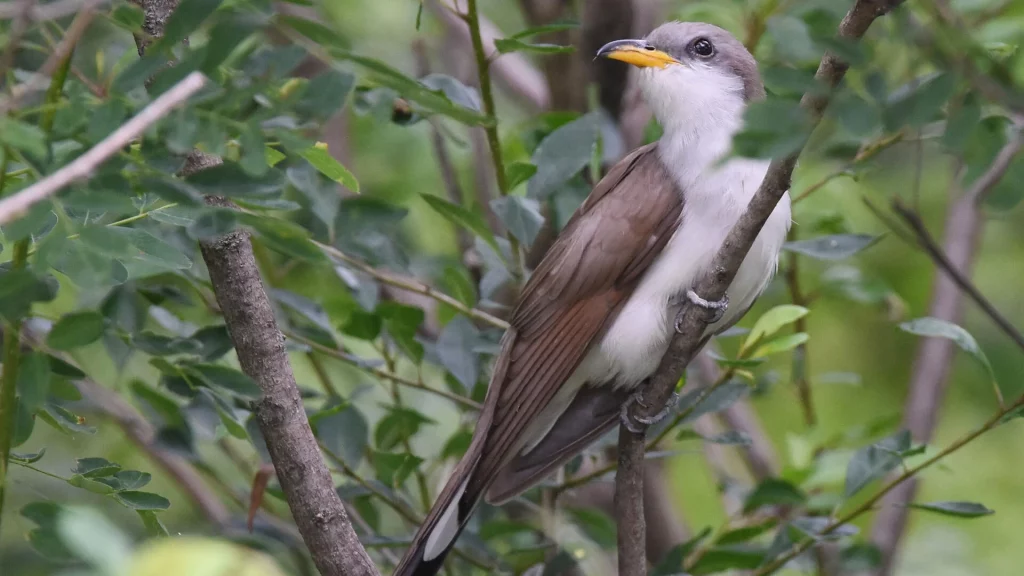
Yellow-billed Cuckoos can be spotted in Iowa during the migration seasons, from April to May and September to October. They are recorded in up to 3% of checklists during migration.
Yellow-billed Cuckoos exhibit a slim, long-tailed body with a yellow bill and grayish-brown plumage. They have a distinct white patch on their tail.
Coccyzus americanus
Length: 11.0-12.6 in (28-32 cm)
Weight: 1.3-2.4 oz (37-68 g)
Wingspan: 18.9-22.0 in (48-56 cm)
Yellow-billed Cuckoos breed in the eastern and central United States and parts of Canada. They migrate to Mexico, Central America, and northern South America for winter.
These cuckoos can be found in wooded habitats, including forests, thickets, and riparian areas. They primarily feed on insects, especially caterpillars.
Yellow-billed Cuckoo Sounds:
Credit: Cody Porter, XC439827. Accessible at www.xeno-canto.org/439827.
Nests of Yellow-billed Cuckoos are built in trees or shrubs, often concealed among foliage. The nests are constructed using twigs, bark strips, and plant fibers. The female lays two to four eggs, which incubate for about two weeks. The young birds leave the nest after another two weeks.
To attract Yellow-billed Cuckoos during migration, provide a habitat with diverse tree species and ample insect populations.
Fun Fact: Yellow-billed Cuckoos are known for their remarkable ability to eat spiky caterpillars, including those with toxic hairs, without apparent harm.
22. Prairie Warbler
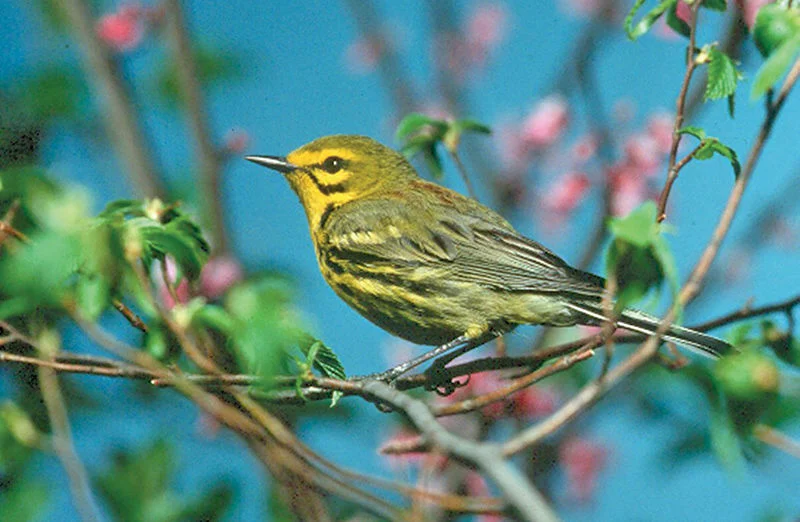
Prairie Warblers can be observed in Iowa as accidental visitors. They are sporadically recorded throughout the year, but their sightings are relatively rare.
Prairie Warblers exhibit a yellow body with black streaking on their sides, back, and throat. Males have bold black facial markings.
Setophaga discolor
Length: 4.3-4.7 in (11-12 cm)
Weight: 0.3-0.4 oz (9-11 g)
Wingspan: 6.3-6.7 in (16-17 cm)
Prairie Warblers breed in the eastern and southeastern United States. They migrate to the Caribbean and Central America for winter.
These warblers are typically found in shrubby habitats, such as grasslands, scrublands, and regenerating forests. They primarily feed on insects.
Prairie Warbler Sounds:
Credit: Peter Boesman, XC470110. Accessible at www.xeno-canto.org/470110.
Nests of Prairie Warblers are built low to the ground, typically hidden among grasses and shrubs. The nests are constructed using grasses, plant fibers, and other fine materials. The female lays three to five eggs, which hatch in about two weeks. The young birds leave the nest after another two weeks.
To attract Prairie Warblers, provide a habitat with open areas, scattered shrubs, and grassy patches.
Fun Fact: Prairie Warblers are known for their distinctive buzzy songs that resemble the sound “zee-zee-zee-zoo-zoo-zee.”
23. Painted Bunting
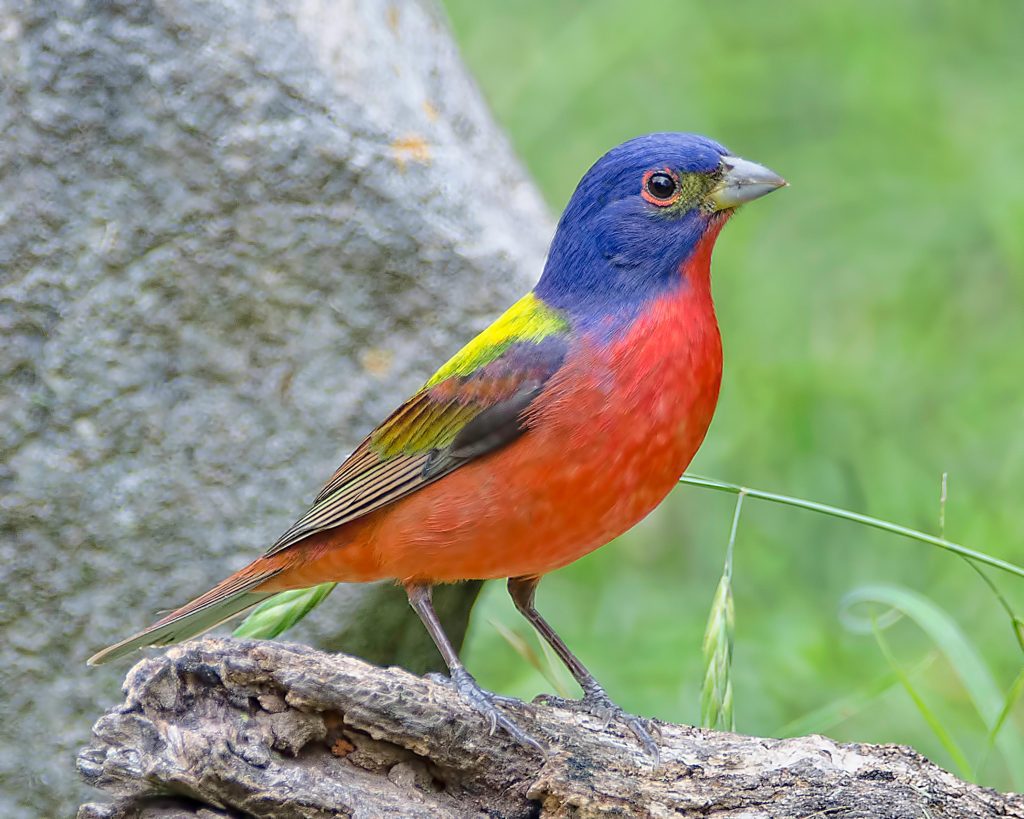
Painted Buntings can be seen in Iowa as accidental visitors. Their sightings are relatively rare, but they occasionally appear.
Male Painted Buntings exhibit vibrant plumage with a mix of bright colors, including blue, green, and red. Females, on the other hand, have a greenish-yellow body.
Passerina ciris
Length: 4.7-5.1 in (12-13 cm)
Weight: 0.6-0.8 oz (17-23 g)
Wingspan: 7.5 in (19 cm)
Painted Buntings breed in the southeastern United States and migrate to Mexico and Central America for winter.
These buntings can be found in brushy habitats, including thickets, woodland edges, and gardens. They primarily feed on seeds, fruits, and insects.
Painted Bunting Sounds:
Credit: Patrick Aberg, XC657965. Accessible at www.xeno-canto.org/657965.
Nests of Painted Buntings are built in dense shrubs or small trees, often concealed among vegetation. The nests are constructed using grasses, leaves, and other plant materials. The female lays three to four eggs, which incubate for about two weeks. The young birds leave the nest after another two weeks.
To attract Painted Buntings, provide dense shrubs, offer a variety of seeds and fruits, and maintain a welcoming garden habitat.
Fun Fact: Male Painted Buntings undergo a molt in late summer, where their bright plumage is replaced with more muted colors resembling females.
24. Evening Grosbeak
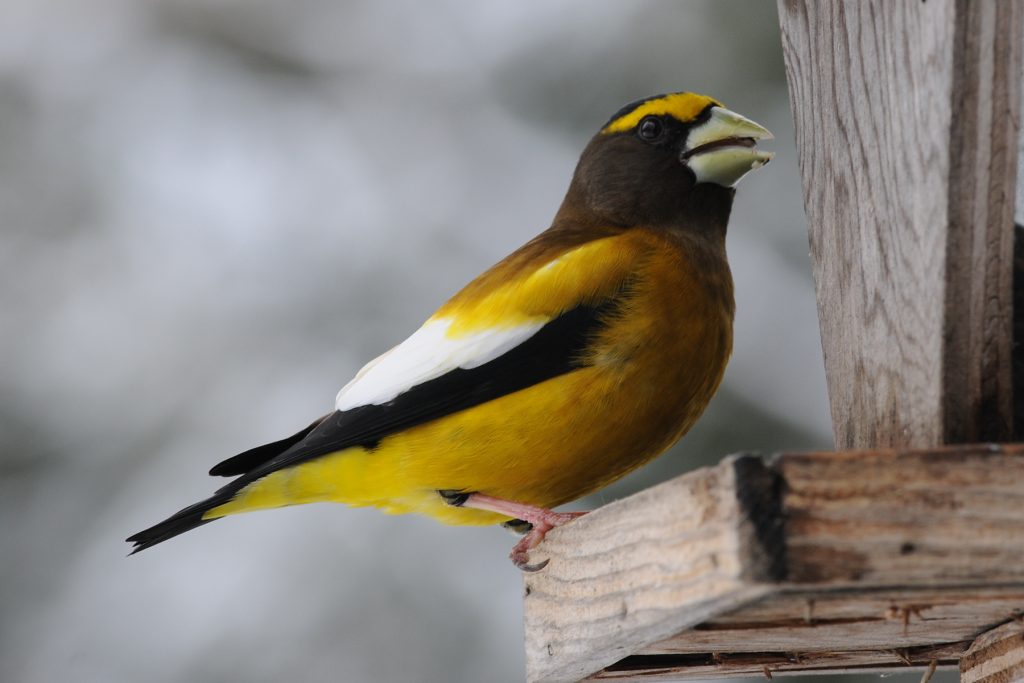
Evening Grosbeaks can be observed in Iowa as accidental visitors. Their sightings are infrequent but can occur during certain years when they irrupt into areas outside their usual range.
Evening Grosbeaks exhibit a robust body with a large, conical bill. Males have bright yellow plumage on their body, with a black forehead and wings. Females are more muted, with a grayish-brown body and yellow accents.
Coccothraustes vespertinus
Length: 6.7-8.7 in (17-22 cm)
Weight: 2.0-3.3 oz (56-93 g)
Wingspan: 12.6-15.4 in (32-39 cm)
Evening Grosbeaks breed in coniferous forests across northern North America. They may migrate irregularly in search of food, sometimes reaching areas outside their typical range.
These grosbeaks are often found in mixed forests, particularly those with spruce, fir, and pine trees. They primarily feed on seeds, buds, and fruits.
Evening Grosbeak Sounds:
Credit: Andrew Spencer, XC394083. Accessible at www.xeno-canto.org/394083.
Nests of Evening Grosbeaks are built on tree branches, typically high up in coniferous trees. The nests are constructed using twigs, bark strips, and rootlets, lined with finer materials like grass and moss. The female lays three to four eggs, which incubate for about two weeks. The young birds leave the nest after another three weeks.
To attract Evening Grosbeaks during their sporadic visits, provide ample food sources such as sunflower seeds, suet, and fruits.
Fun Fact: Evening Grosbeaks are highly gregarious birds and often form large flocks that can be heard from a distance with their loud, melodious calls.
25. Western Tanager

Western Tanagers can be seen in Iowa as accidental visitors. Their sightings are relatively rare but can occur during migration.
Western Tanagers exhibit a striking appearance, with a bright yellow body, a red-orange head, and black wings with white wing bars. Females have a more muted coloration, with yellow-green tones.
Piranga ludoviciana
Length: 6.3-7.1 in (16-18 cm)
Weight: 0.7-1.0 oz (19-28 g)
Wingspan: 9.8-10.6 in (25-27 cm)
Western Tanagers breed in western North America and parts of Canada. They migrate to Mexico and Central America for winter.
These tanagers can be found in various habitats, including coniferous forests, open woodlands, and parks. They primarily feed on insects and fruits.
Western Tanager Sounds:
Credit: Cody Porter, XC545619. Accessible at www.xeno-canto.org/545619.
Nests of Western Tanagers are built on horizontal tree branches, typically high up in coniferous trees. The nests are constructed using twigs, grasses, and fine plant materials. The female lays three to five eggs, which hatch in about two weeks. The young birds leave the nest after another two weeks.
To attract Western Tanagers during their accidental visits, provide a habitat with diverse trees, shrubs, and fruit-bearing plants.
Fun Fact: Male Western Tanagers undergo a molt after the breeding season, replacing their bright breeding plumage with more muted colors resembling females.
26. Lesser Goldfinch
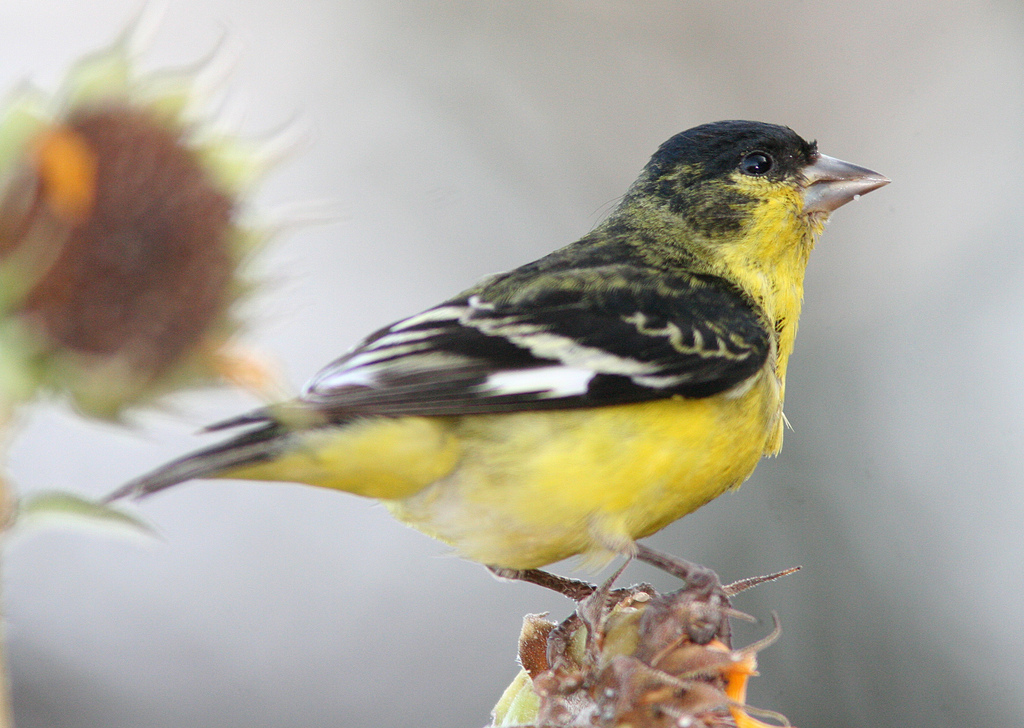
Lesser Goldfinches can be observed in Iowa as accidental visitors. Their sightings are relatively rare but can occur during migration or as individuals stray outside their usual range.
Lesser Goldfinches exhibit a small, compact body with a conical bill. Males have bright yellow underparts and a black back, head, and wings. Females have duller yellow underparts and olive-green upperparts.
Spinus psaltria
Length: 4.3-4.7 in (11-12 cm)
Weight: 0.3-0.4 oz (8-11 g)
Wingspan: 7.5 in (19 cm)
Lesser Goldfinches breed in the southwestern United States and parts of Mexico. They may migrate irregularly, sometimes reaching areas outside their typical range.
These goldfinches are often found in a variety of habitats, including open woodlands, scrublands, and gardens. They primarily feed on seeds, especially those of various thistle species.
Lesser Goldfinch Sounds:
Credit: Andrew Spencer, XC557788. Accessible at www.xeno-canto.org/557788.
Nests of Lesser Goldfinches are built in shrubs or trees, typically near the end of branches. The nests are constructed using plant fibers, grasses, and fine materials. The female lays three to five eggs, which incubate for about two weeks. The young birds leave the nest after another two weeks.
To attract Lesser Goldfinches during their accidental visits, provide nyjer or thistle seeds in appropriate feeders and create a habitat with shrubs and trees for nesting and perching.
Fun Fact: Lesser Goldfinches are known for their acrobatic feeding behavior, often hanging upside down or sideways while foraging on plant stems.
27. Scott’s Oriole
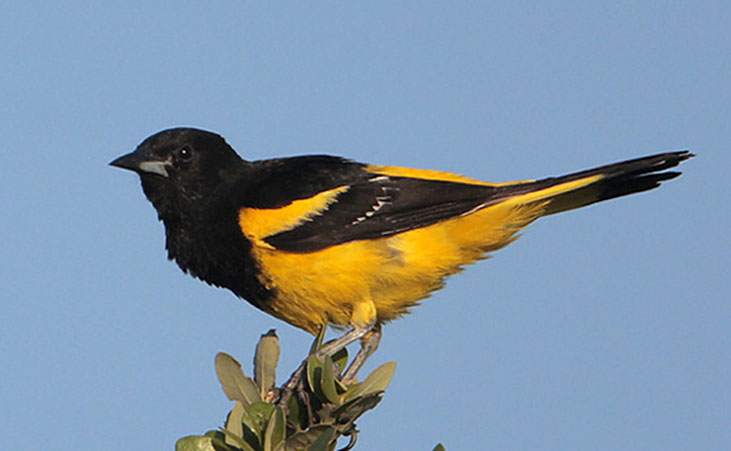
Scott’s Orioles can be spotted in Iowa as accidental visitors. Their sightings are relatively rare but can occur during migration or when individuals stray outside their usual range.
Scott’s Orioles exhibit a vibrant yellow body with black wings and tail. Males have a black throat and face, while females have a grayish throat and face.
Icterus parisorum
Length: 7.5-8.3 in (19-21 cm)
Weight: 1.0-1.3 oz (29-38 g)
Wingspan: 12.2-13.4 in (31-34 cm)
Scott’s Orioles breed in the southwestern United States and parts of Mexico. They may migrate irregularly, sometimes reaching areas outside their typical range.
These orioles are often found in arid habitats, including deserts, scrublands, and canyons. They primarily feed on insects, nectar, and fruit.
Scott’s Oriole Sounds:
Credit: Andrew Spencer, XC609581. Accessible at www.xeno-canto.org/609581.
Nests of Scott’s Orioles are built in trees, typically in forked branches. The nests are constructed using grasses, plant fibers, and other fine materials, often incorporating pieces of spider silk for added strength. The female lays three to five eggs, which incubate for about two weeks. The young birds leave the nest after another two weeks.
To attract Scott’s Orioles during their accidental visits, provide nectar feeders, fruit offerings, and a habitat with suitable perching and nesting locations.
Fun Fact: Scott’s Orioles have a unique way of obtaining water by piercing cacti with their beaks to access the moisture inside.
28. Indigo Bunting

Indigo Buntings can be observed in Iowa as accidental visitors. Their sightings are relatively rare but can occur during migration or as individuals stray outside their usual range.
Indigo Buntings exhibit a vibrant blue plumage in males, while females have a more muted brown appearance with slight blue accents.
Passerina cyanea
Length: 4.7-5.1 in (12-13 cm)
Weight: 0.4-0.5 oz (12-14 g)
Wingspan: 7.5 in (19 cm)
Indigo Buntings breed in the eastern and central United States and parts of Canada. They migrate to Mexico and Central America for winter.
These buntings are often found in various habitats, including open woodlands, brushy areas, and gardens. They primarily feed on seeds and insects.
Indigo Bunting Sounds:
Credit: Andrew Spencer, XC398102. Accessible at www.xeno-canto.org/398102.
Nests of Indigo Buntings are built in shrubs or small trees, typically low to the ground. The nests are constructed using grasses, leaves, and other fine plant materials. The female lays three to four eggs, which hatch in about two weeks. The young birds leave the nest after another two weeks.
To attract Indigo Buntings during their accidental visits, provide a habitat with shrubs, offer a variety of seeds, and maintain a welcoming garden environment.
Fun Fact: Male Indigo Buntings acquire their brilliant blue plumage through a process called structural coloration, where the feathers reflect and scatter light to create the vibrant blue appearance.
29. Blue Grosbeak
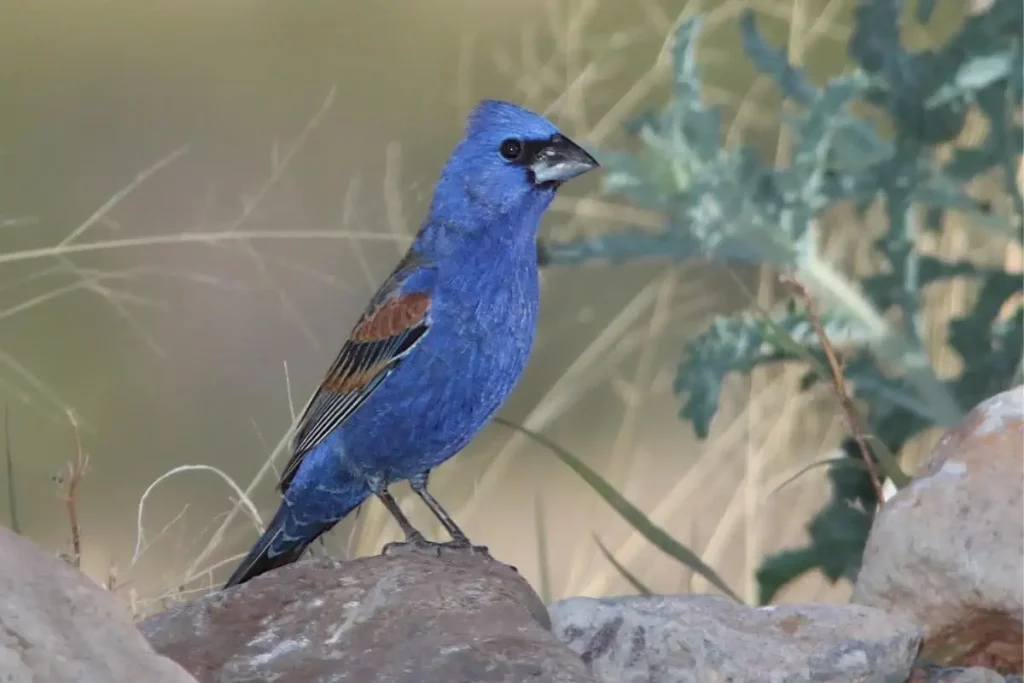
Blue Grosbeaks can be seen in Iowa as accidental visitors. Their sightings are relatively rare but can occur during migration or as individuals stray outside their usual range.
Blue Grosbeaks exhibit a deep blue body with rusty-brown wing patches. Males have a distinctive large silver bill. Females have a more muted appearance with brownish tones.
Passerina caerulea
Length: 5.5-6.7 in (14-17 cm)
Weight: 0.9-1.0 oz (25-28 g)
Wingspan: 9.1-9.8 in (23-25 cm)
Blue Grosbeaks breed in the southern United States and parts of Mexico. They migrate to Mexico and Central America for winter.
These grosbeaks are often found in open habitats, including grasslands, brushy areas, and edges of woodlands. They primarily feed on seeds and insects.
Blue Grosbeak Sounds:
Credit: Andrew Spencer, XC557774. Accessible at www.xeno-canto.org/557774.
Nests of Blue Grosbeaks are built in shrubs or small trees, typically low to the ground. The nests are constructed using grasses, rootlets, and other fine materials. The female lays three to five eggs, which incubate for about two weeks. The young birds leave the nest after another two weeks.
To attract Blue Grosbeaks during their accidental visits, provide a habitat with shrubs, open areas, and a variety of seeds.
Fun Fact: Blue Grosbeaks were historically known as “Indigo Buntings,” and their distinctiveness as a separate species was recognized only in the 19th century.
30. Lazuli Bunting
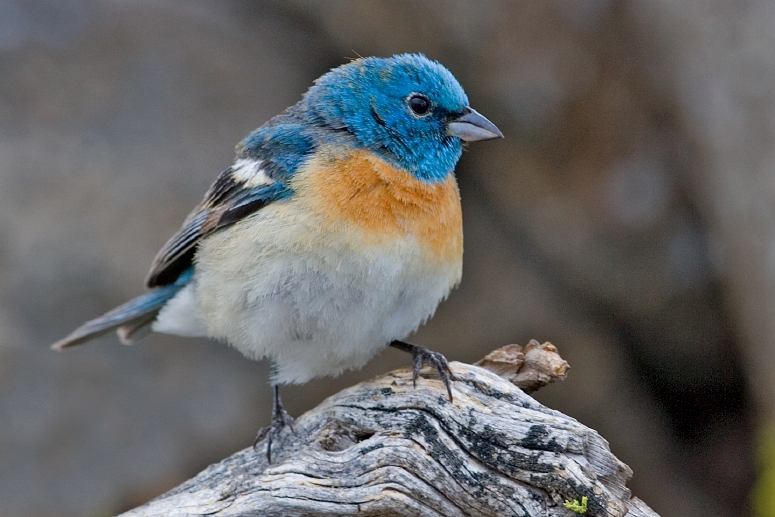
Lazuli Buntings can be observed in Iowa as accidental visitors. Their sightings are relatively rare but can occur during migration or as individuals stray outside their usual range.
Lazuli Buntings exhibit a striking appearance, with bright blue plumage on the head, back, and upperparts, transitioning to a warm rusty-brown on the breast and underparts.
Passerina amoena
Length: 4.7-5.1 in (12-13 cm)
Weight: 0.4-0.6 oz (12-17 g)
Wingspan: 7.5 in (19 cm)
Lazuli Buntings breed in the western United States and parts of Canada. They migrate to Mexico and Central America for winter.
These buntings are often found in open habitats, including woodlands, shrubby areas, and streamside
vegetation. They primarily feed on seeds and insects.
Lazuli Bunting Sounds:
Credit: Andrew Spencer, XC498150. Accessible at www.xeno-canto.org/498150.
Nests of Lazuli Buntings are built in shrubs or small trees, typically low to the ground. The nests are constructed using grasses, bark strips, and other fine materials. The female lays three to five eggs, which incubate for about two weeks. The young birds leave the nest after another two weeks.
To attract Lazuli Buntings during their accidental visits, provide a habitat with shrubs, open areas, and a variety of seeds.
Fun Fact: The vibrant blue color of Lazuli Buntings is produced by microscopic air bubbles in their feather barbules, which scatter and reflect light to create the blue appearance.
Discovering the Occurrence of Yellow Avian Creatures in Iowa during the Seasons of Summer and Winter
Unveiling the frequency of yellow-feathered birds observed in Iowa’s vibrant landscapes can be efficiently accomplished through the utilization of comprehensive inventories. These inventories effectively highlight the prevailing presence of various species on ebird checklists during the summertime and wintertime in the state of Iowa.
Yellow Birds in Iowa during the Summer:
1. The American Goldfinch emerges as the most abundant species, constituting a substantial 46.7% of the recorded sightings.
2. Following closely behind is the Baltimore Oriole, impressively accounting for 37.5% of the checklists.
3. The Common Yellowthroat occupies a notable position, with 37.1% of birdwatchers noting its presence.
4. The American Redstart exhibits a relatively frequent appearance, garnering a share of 20.9% in the checklists.
5. The Yellow Warbler, admired for its vibrant plumage, maintains a respectable presence at 20.4%.
6. Among the diverse avian inhabitants, the Dickcissel secures a solid standing at 19.8%.
7. The Eastern Meadowlark, with its enchanting melodies, captures the attention of observers at 15.7%.
8. A modest proportion of 12.1% is allocated to the graceful Cedar Waxwing.
9. The Yellow-rumped Warbler, boasting distinctive markings, grasps the interest of 10.8% of bird enthusiasts.
10. Following closely behind is the Yellow-throated Vireo, making its presence known at 10.6%.
11. The Orchard Oriole, recognized for its vibrant colors, impresses with a representation of 8.7%.
12. The Nashville Warbler, known for its melodious songs, captures the interest of 7.6% of observers.
13. The Scarlet Tanager, with its striking red plumage, makes an appearance on 6.4% of the checklists.
14. The Palm Warbler, characterized by its distinctive tail wagging, marks its presence at 5.5%.
15. A modest portion of 4.0% is allocated to the Magnolia Warbler, showcasing its charming appearance.
16. The Orange-crowned Warbler, with its subtle yet alluring hues, garners a share of 3.4%.
17. The illustrious Wilson’s Warbler earns a modest representation, accounting for 3.3% of observations.
18. Observers note the Yellow-headed Blackbird, capturing attention at 3.2%.
19. A minor presence of the Western Meadowlark is observed, comprising merely 2.9% of the checklists.
20. The Black-throated Green Warbler establishes its mark with 2.2% representation.
21. An unassuming share of 2.1% is granted to the Blue-winged Warbler.
22. The vibrant Summer Tanager, adorning the landscapes, secures a share of 2.0%.
23. The Prothonotary Warbler, displaying its golden feathers, emerges with a representation of 1.7%.
24. A modest fraction of 1.4% is attributed to both the Canada Warbler and the Yellow-throated Warbler.
25. The White-eyed Vireo, with its distinctively colored eyes, captures interest at 0.7%.
26. A marginal presence of 0.7% is observed for the Cape May Warbler.
27. The Western Kingbird, boasting its regal appearance, marks its presence at 0.5%.
28. The Hooded Warbler, characterized by its unique hooded markings, garners a meager 0.2%.
29. Both the Pine Warbler and the Prairie Warbler maintain a minor representation of 0.2%.
30. The Western Tanager, with its dazzling plumage, appears in less than 0.1% of observations.
31. Both the Painted Bunting and the Evening Grosbeak make fleeting appearances, each capturing less than 0.1% of checklists.
32. The Hooded Oriole, known for its distinctive vocalizations, completes the list with a marginal presence of less than 0.1%.
Yellow Birds in Iowa during the Winter:
1. During the winter season, the American Goldfinch remains a prevalent species, comprising 24.4% of the recorded sightings.
2. The Cedar Waxwing, with its graceful flight, claims a modest representation of 3.4%.
3. A fleeting appearance of the Yellow-rumped Warbler is recorded, accounting for 0.5%.
4. The Western Meadowlark maintains a minor presence, constituting 0.3% of observations.
5. The Eastern Meadowlark is observed in a mere 0.1% of the checklists.
6. The Evening Grosbeak and the Orange-crowned Warbler make transitory appearances, each capturing less than 0.1% of observations.
7. The Dickcissel and the Yellow-headed Blackbird secure brief mentions, each accounting for less than 0.1%.
8. The Lesser Goldfinch, Baltimore Oriole, Common Yellowthroat, Nashville Warbler, Palm Warbler, Summer Tanager, White-eyed Vireo, Cape May Warbler, Pine Warbler, and Western Tanager all make fleeting appearances, each capturing less than 0.1% of the checklists.
